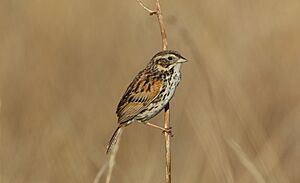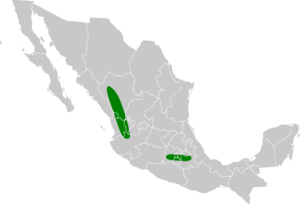Sierra Madre sparrow facts for kids
Quick facts for kids Sierra Madre sparrow |
|
|---|---|
 |
|
| Conservation status | |
| Scientific classification | |
| Genus: |
Xenospiza
|
| Species: |
baileyi
|
| Subspecies | |
|
|
 |
|
| Synonyms | |
|
|
The Sierra Madre sparrow (Xenospiza baileyi) is a special bird found only in Mexico. It's also called Bailey's sparrow. This small American sparrow is quite mysterious and lives in only a few places. Sadly, it's an endangered bird because its home, or habitat, is disappearing.
What's in a Name?
Why is it Called Xenospiza?
The scientific name Xenospiza comes from two old Ancient Greek words. Xénos means "a stranger," and spíza means "finch." So, its name means "stranger finch."
Who is Bailey?
The second part of its name, baileyi, honors Alfred Marshall Bailey. He was the person who collected a specimen of this bird in 1931. This specimen helped scientists understand it was a new species.
Discovery and History
When Was the Sierra Madre Sparrow Found?
Scientists first found the Sierra Madre sparrow in 1889. This happened near a place called Bolaños in Jalisco, Mexico. At first, they didn't realize it was a new species. They thought these birds were just unusual Savannah sparrows or Mexican Plateau song sparrows. Some even thought they might be hybrids, which are mixes of two different species.
Recognizing a New Species
It wasn't until 1931 that another bird was found near the city of Durango. This time, scientists realized it was a completely new and unique species.
Finding More Populations
A southern group of these sparrows was discovered in 1945. Since then, they have been seen in several areas around Mexico City, Morelos, and Estado de México. For many years, between 1951 and 2004, the northern group of sparrows from Jalisco and Durango was not seen. People thought they might have disappeared.
Rediscovery and Genetic Differences
However, a small group was found again in 2004 in the same area near El Salto. Even though there are two groups, they don't mix or breed with each other. This means they are like two separate, important groups that have evolved differently. The Sierra Madre sparrow is the only species in its genus called Xenospiza. It is closely related to another bird genus called Melospiza. These sparrows live in high mountain grasslands.
Where Do They Live?
Their Mountain Home
The Sierra Madre sparrow lives only in certain mountain ranges in Mexico. These mountains are part of or near the Sierra Madre Occidental. They prefer areas with special types of grass called bunchgrass and marshlands. These habitats are found in volcanic mountains.
Altitude Preferences
The northern group of sparrows lives at lower altitudes, around 2,300 to 3,050 meters (about 7,500 to 10,000 feet) high. The southern group lives at higher altitudes within this range.
What Their Habitat Looks Like
For the northern group, we don't know much about their exact habitat. But we do know they are found near pine, oak, and Arbutus trees. For the southern group, we have more details. Their main grasses include Festuca amplissima, Peruvian feather grass (Stipa ichu), and two types of muhly grass (Muhlenbergia affinis and Muhlenbergia macroura). You might also find small groups of Montezuma Pine (Pinus montezumae) and Lumholtz' Pine (P. lumholtzii) trees on higher ground.
Conservation Status
Why Are They Endangered?
The Sierra Madre sparrow is in great danger. Its habitat is being cleared away to create pastures for animals. Because of this, its conservation status on the IUCN Red List is Endangered. This means there are very few of them left.
Shrinking Numbers
The species lives in an area smaller than 5,000 square kilometers (about 1,900 square miles). Its living space, the available habitat, and the number of birds are all getting smaller. Even though the northern group was found again, only a few birds are known to exist. Scientists urgently need to find more groups of these sparrows.
Future Outlook
It's possible that the Sierra Madre sparrow will soon be listed as Critically Endangered. This is an even more serious category. Out of the four known groups of these birds, only one, near La Cima, seems to have a reasonable number of individuals.


